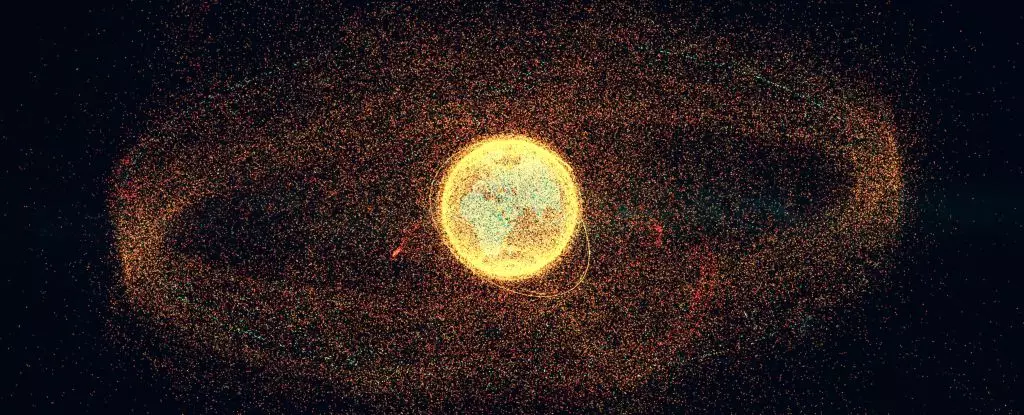The vastness of outer space has long intrigued humanity, but now it presents a formidable challenge that demands immediate attention: the growing menace of space debris. Once an overlooked issue, the accumulation of junk in Earth’s orbit has skyrocketed, raising alarm among scientists and space agencies worldwide. The European Space Agency (ESA) recently reported that the amount of debris is not merely increasing; it’s reaching a critical saturation point. This trend can be traced back to the rapid deployment of satellites, which far exceeds the rate at which old or malfunctioning objects return to Earth. As a direct consequence, the situation is evolving toward a potential catastrophe of unprecedented scale.
What makes this problem particularly alarming is the phenomenon known as the Kessler Syndrome, where collisions between debris objects create additional fragments, fueling an exponential increase in space junk. Even if all launches were halted today, the debris population would continue to grow for years due to the persistence of fragmentation events. It’s a stark reminder that inaction is not an option. The time for complacency has passed; urgent action is necessary to avert a scenario where certain orbits become permanently unusable.
The Numbers Behind the Crisis: A Sobering Reality
ESA’s reports reveal significant figures that underscore the severity of this crisis. As of 2025, monitoring programs are keeping tabs on about 40,000 objects in orbit, with only approximately 11,000 being functional satellites. The vast imbalance becomes apparent when we delve deeper: an estimated 54,000 items larger than 10 centimeters and a staggering 1.2 million objects between 1 and 10 centimeters plague our orbital path. Even minuscule bits of debris, measuring between 1 millimeter and 1 centimeter, can pose catastrophic risks to operational spacecraft like the International Space Station and prestigious instruments such as the Hubble Space Telescope.
These figures evoke a sense of vulnerability for our technological infrastructure in space, revealing how easily an operational satellite can fall victim to an invisible threat. Moreover, fragmentation events—often precipitated by non-collisional failures—have emerged as the leading source of new debris, indicating a multifaceted problem that transcends mere collisions. In 2024 alone, there were recorded instances resulting in thousands of new debris pieces, highlighting the unpredictability of space junk generation.
Progress and Challenges: The Tightrope Walk of Space Management
Despite the daunting statistics, there are notable strides being made in combating space debris. The trend of controlled atmospheric entries for defunct satellites and rocket stages has seen promising enhancement, with a marked increase in successful discharges. More than 90 percent of rocket bodies remaining in low-Earth orbit have complied with re-entry standards, demonstrating a commitment to responsible space management. This progress embodies a step toward a healthier cosmic ecosystem, reassuring us that proactive measures can yield positive outcomes.
Yet, even with these successes, the challenges remain enormous and complex. The need for global cooperation in the effort to clean up our orbital surroundings is both urgent and formidable. Nations must come together, establishing collaborative frameworks that transcend borders and prioritize space sustainability. The absence of a unified approach could stall any efforts to address the rampant issue of space debris, allowing it to spiral further out of control.
Innovative Solutions: Reimagining Space Repair and Cleanup
Emerging technologies and inventive strategies may provide the beacon of hope we desperately need. Solutions like robotic servicers and autonomous cleanup satellites hold the promise to not only remove debris but also repair satellites already in orbit, extending their lifespans and mitigating the risk of collisions. Conceptual projects such as nets, harpoons, and laser systems aimed at removing space junk are becoming increasingly viable, but serious engineering challenges remain.
Moreover, public-private partnerships could fuel innovation by leveraging the expertise of the aerospace industry alongside governmental resources. Incentivizing commercial involvement in space debris management can catalyze the development of smart technologies, ultimately leading to safer and cleaner orbital environments.
A Call to Action: The Responsibility of All Humanity
The issue of space debris transcends mere scientific concern; it resonates with every individual on Earth as we rely increasingly on satellite technology for communication, navigation, and scientific research. The responsibility to protect our orbital environment falls upon each and every one of us—from policy-makers to casual space enthusiasts. Ongoing awareness and dialogue surrounding this subject are vital for nurturing a culture of stewardship toward our shared cosmic realm.
Without timely intervention, we may find ourselves grappling with an impenetrable sphere of junk that renders significant portions of outer space no longer usable. The urgency to act cannot be overstated; the cosmic future of our planet may depend on it. As we navigate these treacherous waters, we must harness our ingenuity and collaboration, fortifying our course toward a cleaner, safer, and more sustainable extraterrestrial landscape.


Leave a Reply